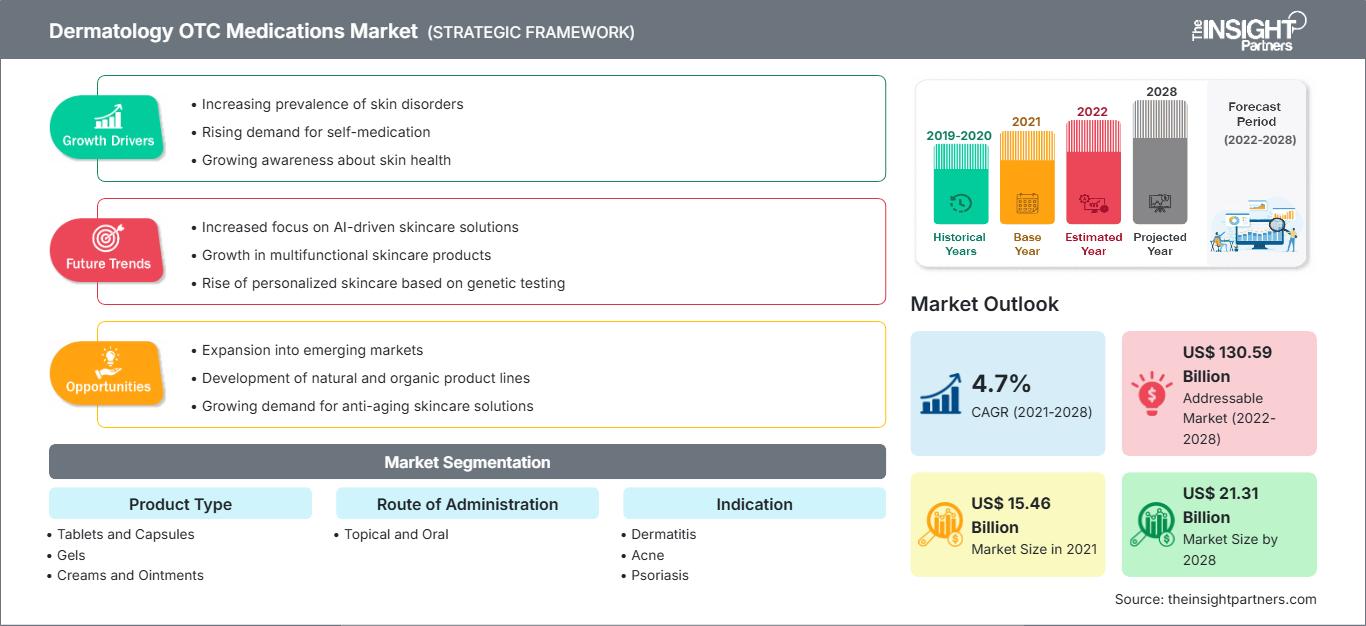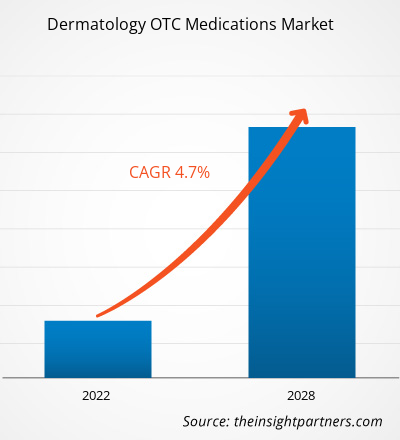[Forschungsbericht]Der Markt für rezeptfreie Dermatologie-Medikamente soll von 15.456,63 Millionen US-Dollar im Jahr 2021 auf 21.313,40 Millionen US-Dollar im Jahr 2028 wachsen; die durchschnittliche jährliche Wachstumsrate (CAGR) von 4,7 % wird für den Zeitraum von 2021 bis 2028 geschätzt.
OTC-Dermatologie-Medikamente werden ohne Rezept eines Arztes direkt an den Verbraucher verkauft, im Gegensatz zu verschreibungspflichtigen Medikamenten, die nur an Verbraucher mit einem gültigen Rezept verkauft werden dürfen. OTC-Medikamente werden von einer Regulierungsbehörde ausgewählt, um sicherzustellen, dass sie Inhaltsstoffe enthalten, die bei der Anwendung ohne ärztliche Aufsicht sicher und wirksam sind. OTC-Medikamente werden in der Regel nach ihrem aktiven pharmazeutischen Inhaltsstoff (API) und nicht nach dem Endprodukt reguliert. Durch die Regulierung von APIs anstelle spezifischer Arzneimittelformulierungen geben Regierungen Herstellern die Freiheit, Inhaltsstoffe oder Inhaltsstoffkombinationen zu proprietären Mischungen zusammenzustellen.
Der Markt für rezeptfreie dermatologische Medikamente ist nach Produkttyp, Verabreichungsweg, Indikation, Vertriebskanal und geografischer Lage segmentiert. Geografisch ist der Markt grob in Nordamerika, Europa, den asiatisch-pazifischen Raum, den Nahen Osten und Afrika (MEA) sowie Süd- und Mittelamerika unterteilt. Der Bericht bietet Einblicke und detaillierte Analysen des Marktes und betont Parameter wie Markttrends, technologische Fortschritte und Marktdynamik sowie die Analyse der Wettbewerbslandschaft der weltweit führenden Marktteilnehmer.
Passen Sie diesen Bericht Ihren Anforderungen an
Sie erhalten kostenlos Anpassungen an jedem Bericht, einschließlich Teilen dieses Berichts oder einer Analyse auf Länderebene, eines Excel-Datenpakets sowie tolle Angebote und Rabatte für Start-ups und Universitäten.
Markt für rezeptfreie Dermatologiemedikamente: Strategische Einblicke

-
Holen Sie sich die wichtigsten Markttrends aus diesem Bericht.Dieses KOSTENLOSE Beispiel umfasst Datenanalysen, die von Markttrends bis hin zu Schätzungen und Prognosen reichen.
Markteinblicke
Hohe Prävalenz von Hautproblemen treibt Wachstum des Marktes für rezeptfreie dermatologische Medikamente an
Die hohe Prävalenz von Hautproblemen und das steigende Einkommen der Mittelschicht dürften das globale Marktwachstum ankurbeln. Der unsachgemäße Gebrauch rezeptfreier Medikamente bremst jedoch das Wachstum des Marktes für rezeptfreie dermatologische Medikamente. Hautprobleme wie Pigmentierung, Fältchen, Falten, Akne und Brandnarben sind weit verbreitet. Laut der American Academy of Dermatology Association (AADA) ist Akne die am weitesten verbreitete Hauterkrankung in den USA und betrifft jährlich etwa 50 Millionen Amerikaner. Außerdem leiden etwa 85 % der 12- bis 24-Jährigen unter leichten Akneproblemen. Die mit der Aknebehandlung verbundenen Kosten und der Produktivitätsverlust der Aknebehandlungspatienten überstiegen 2013 etwa 1,2 Milliarden US-Dollar. im selben Jahr suchten mehr als 5,1 Millionen Menschen, hauptsächlich Kinder und junge Erwachsene, medizinische Behandlung gegen Akne. Darüber hinaus entwickelt jeder Zehnte eine atopische Dermatitis, und laut AADA sind bis zu 25 % der Kinder und 2–3 % der Erwachsenen davon betroffen. Laut einer von Dermstore im Jahr 2021 unter 2.000 Frauen in den USA durchgeführten Umfrage begannen junge Frauen viel früher als ältere Frauen, Produkte zur Verringerung der Zeichen der Hautalterung zu verwenden. Darüber hinaus stufte die Europäische Kommission (EK) Hautkrankheiten als vierthäufigste Ursache für Erkrankungen beim Menschen ein. Acne vulgaris tritt in mehreren Ländern immer häufiger auf. OTC-Dermatologiemedikamente werden häufig zur Behandlung von Akne eingesetzt. Das Verständnis der Merkmale der Belastung durch Acne vulgaris ist entscheidend für die Entwicklung wirksamer und gezielter Aknetherapien. Laut der Global Burden of Disease Study 2019 wurden weltweit 117,4 Millionen Fälle von Akne vulgaris, 231,2 Millionen prävalente Fälle und 5 Millionen behinderungsbereinigte Lebensjahre (DALYs) gemeldet, was einem Anstieg von 48 % seit 1990 entspricht.
Wachsendes Bewusstsein für Hautkrankheiten trägt erheblich zum Marktwachstum bei
Hautkrankheiten beeinträchtigen die Lebensqualität der Menschen in Entwicklungsländern erheblich und führen zu verminderter Produktivität bei der Arbeit und in der Schule sowie zu Diskriminierung aufgrund von Entstellungen. Hautveränderungen können auch auf schwerwiegendere Erkrankungen hinweisen, die einer Behandlung bedürfen. Früher wurden solche Krankheiten von Gesundheitsbehörden übersehen oder ihnen wurde wenig Bedeutung beigemessen, da sie in den meisten Fällen nicht lebensbedrohlich waren und in Zentren der tertiären Versorgung selten auftraten.
Derzeit müssen nationale und internationale Gesundheitszentren medizinisches Personal in Entwicklungsländern schulen, um die Diagnose und Behandlung von Hauterkrankungen zu verbessern.
Die American Academy of Dermatology (AAD) hat mehrere öffentliche Aufklärungsprogramme gestartet, um das Erscheinungsbild von Haut, Haaren und Nägeln zu verbessern. Der Oktober ist beispielsweise der Monat der Aufklärung über Ekzeme und die AAD bietet von Dermatologen geprüfte Informationen, damit Menschen ihr Ekzem besser verstehen und behandeln können. Die Finanzierungsoptionen der American Skin Association (ASA) für 2021 stehen jetzt zur Verfügung, um herausragende dermatologische Forscher und Ärzte zu unterstützen. In den letzten 34 Jahren hat die ASA Hunderte von Zuschüssen gefördert, die zu wichtigen dermatologischen Durchbrüchen und einem besseren Bewusstsein und Wissen über Hauterkrankungen geführt haben. Somit unterstützt das steigende Bewusstsein für Hautkrankheiten das Wachstum des Marktes für rezeptfreie Dermatologie-Medikamente.
Einblicke in Produkttypen
Basierend auf dem Produkttyp ist der globale Markt für rezeptfreie Dermatologie-Medikamente in Tabletten und Kapseln, Gele, Cremes und Salben usw. unterteilt. Das Segment Cremes und Salben hatte 2021 den größten Marktanteil. Es wird jedoch erwartet, dass das Segment Tabletten und Kapseln im Prognosezeitraum die höchste durchschnittliche jährliche Wachstumsrate verzeichnet.
Einblicke in die Verabreichungswege
Basierend auf dem Verabreichungsweg ist der Markt für rezeptfreie Dermatologie-Medikamente in topische und orale Medikamente unterteilt. Das topische Segment hatte 2021 einen größeren Marktanteil; Es wird jedoch geschätzt, dass das orale Segment im Prognosezeitraum eine höhere CAGR verzeichnet.
Einblicke in Indikationen
Basierend auf den Indikationen ist der Markt für rezeptfreie dermatologische Medikamente in Dermatitis, Akne, Psoriasis, Hautbleiche, Pilzerkrankungen, Warzen und andere unterteilt. Das Aknesegment hatte 2021 den größten Marktanteil; es wird jedoch geschätzt, dass es im Prognosezeitraum die höchste CAGR verzeichnet.
Einblicke in Vertriebskanäle
Basierend auf den Vertriebskanälen ist der Markt für rezeptfreie dermatologische Medikamente in Online- und Offline-Vertrieb unterteilt. Das Offline-Vertriebssegment hatte 2021 einen größeren Marktanteil; es wird jedoch geschätzt, dass das Online-Vertriebssegment im Prognosezeitraum eine höhere CAGR verzeichnet. Darüber hinaus ist das Offline-Vertriebssegment in Einzelhandels- und Krankenhausapotheken sowie Super- und Hypermärkte unterteilt. Der Einzelhandels- und Das Segment der Krankenhausapotheken hatte 2021 einen größeren Marktanteil.
Produkteinführungen, Fusionen und Übernahmen sind die am häufigsten verfolgten Strategien der Akteure auf dem globalen Markt für rezeptfreie dermatologische Medikamente. Nachstehend sind einige der wichtigsten Produktentwicklungen der letzten Zeit aufgeführt:
Im August 2020 gab Perrigo Company plc, ein weltweit führender Anbieter hochwertiger und erschwinglicher Selbstpflegeprodukte, die Übernahme von drei osteuropäischen rezeptfreien Hautpflege- und Haarausfallbehandlungsmarken (Emolium, Iwostin und Loxon) von Sanofi bekannt.
Im April 2018 gab Sol-Gel Technologies Ltd., ein Dermatologieunternehmen im klinischen Stadium, das sich auf die Identifizierung, Entwicklung und Vermarktung von Marken- und Generika-Arzneimitteln zur topischen Anwendung zur Behandlung von Hautkrankheiten konzentriert, die Zusammenarbeit mit Perrigo Israel, einem Tochterunternehmen von Perrigo Company plc, bei der Entwicklung, Herstellung und Vermarktung eines generischen Produktkandidaten bekannt.
Die COVID-19-Pandemie hat die Gesundheitsbranche weltweit erheblich belastet. Während sich die Welt langsam erholt, werden Geschäfte nie wieder so sein wie zuvor. COVID-19 hat die Unternehmenslandschaft generell verändert. Mehrere Unternehmen erlitten im letzten Quartal 2019 schwere Verluste, was sich negativ auf das erste und zweite Quartal 2020 auswirkte. Forschungs- und Entwicklungsaktivitäten zur Identifizierung der Bedrohung durch das SARS-CoV-2-Virus für betroffene Patienten werden das Wachstum des Marktes für rezeptfreie dermatologische Medikamente wahrscheinlich bremsen. Die Auswirkungen der COVID-19-Pandemie auf den Markt für rezeptfreie dermatologische Medikamente waren daher unmittelbar und drastisch. Die Nachfrage nach rezeptfreien dermatologischen Medikamenten ist aufgrund des COVID-19-Ausbruchs gesunken, da sich der Schwerpunkt im Gesundheitswesen auf die Rettung von Menschenleben verlagert hat. Die COVID-19-Pandemie verursacht massive Störungen in den globalen Lieferketten, auf den Verbrauchermärkten und in der Weltwirtschaft. Infolge der von Regierungen weltweit ergriffenen Maßnahmen besteht das Risiko eines vorübergehenden und erheblichen Rückgangs der Nachfrage nach rezeptfreien dermatologischen Medikamenten. Daher hat sich die Pandemie negativ auf den Markt für rezeptfreie Dermatologie-Medikamente ausgewirkt.
Marktsegmentierung für rezeptfreie Dermatologie-Medikamente
Der globale Markt für rezeptfreie Dermatologie-Medikamente ist nach Art, Technologie, Dienstleistungen und Geografie segmentiert. Basierend auf dem Produkttyp wurde der Markt in Tabletten und Kapseln, Gele, Cremes und Salben und Sonstiges unterteilt. Basierend auf der Verabreichungsart ist der Markt für rezeptfreie Dermatologie-Medikamente in topische und orale Mittel unterteilt. Basierend auf der Indikation ist der Markt für rezeptfreie Dermatologie-Medikamente in Dermatitis, Akne, Psoriasis, Hautbleichmittel, Pilzerkrankungen, Warzen und Sonstiges segmentiert. Basierend auf dem Vertriebskanal ist der Markt in Online- und Offline-Vertrieb unterteilt. Der Markt für rezeptfreie Dermatologie-Medikamente ist geografisch grob in Nordamerika, Europa, Asien-Pazifik, den Nahen Osten und Afrika sowie Süd- und Mittelamerika.
Markt für rezeptfreie Dermatologie-Medikamente
Die Analysten von The Insight Partners haben die regionalen Trends und Faktoren, die den Markt für rezeptfreie Dermatologie-Medikamente im Prognosezeitraum beeinflussen, ausführlich erläutert. In diesem Abschnitt werden auch die Marktsegmente und die geografische Lage für rezeptfreie Dermatologie-Medikamente in Nordamerika, Europa, Asien-Pazifik, dem Nahen Osten und Afrika sowie Süd- und Mittelamerika erörtert.Umfang des Marktberichts über rezeptfreie Dermatologiemedikamente
| Berichtsattribut | Einzelheiten |
|---|---|
| Marktgröße in 2021 | US$ 15.46 Billion |
| Marktgröße nach 2028 | US$ 21.31 Billion |
| Globale CAGR (2021 - 2028) | 4.7% |
| Historische Daten | 2019-2020 |
| Prognosezeitraum | 2022-2028 |
| Abgedeckte Segmente |
By Produkttyp
|
| Abgedeckte Regionen und Länder |
Nordamerika
|
| Marktführer und wichtige Unternehmensprofile |
|
Dichte der Marktteilnehmer für rezeptfreie Dermatologiemedikamente: Auswirkungen auf die Geschäftsdynamik verstehen
Der Markt für rezeptfreie Dermatologie-Medikamente wächst rasant. Dies ist auf die steigende Nachfrage der Endverbraucher zurückzuführen, die auf Faktoren wie veränderte Verbraucherpräferenzen, technologische Fortschritte und ein stärkeres Bewusstsein für die Produktvorteile zurückzuführen ist. Mit der steigenden Nachfrage erweitern Unternehmen ihr Angebot, entwickeln Innovationen, um den Bedürfnissen der Verbraucher gerecht zu werden, und nutzen neue Trends, was das Marktwachstum weiter ankurbelt.
- Holen Sie sich die Markt für rezeptfreie Dermatologiemedikamente Übersicht der wichtigsten Akteure
Firmenprofile
- Bausch Health Companies Inc.
- Perrigo Company plc
- Bayer AG
- Viatris Inc.
- Johnson and Johnson Services, Inc.
- LEO Pharma A/S
- GlaxoSmithKline plc.
- Galderma
- Dr. Reddy's Laboratories
- ACELLA PHARMACEUTICALS, LLC
- Historische Analyse (2 Jahre), Basisjahr, Prognose (7 Jahre) mit CAGR
- PEST- und SWOT-Analyse
- Marktgröße Wert/Volumen – Global, Regional, Land
- Branchen- und Wettbewerbslandschaft
- Excel-Datensatz
Aktuelle Berichte
Erfahrungsberichte
Grund zum Kauf
- Fundierte Entscheidungsfindung
- Marktdynamik verstehen
- Wettbewerbsanalyse
- Kundeneinblicke
- Marktprognosen
- Risikominimierung
- Strategische Planung
- Investitionsbegründung
- Identifizierung neuer Märkte
- Verbesserung von Marketingstrategien
- Steigerung der Betriebseffizienz
- Anpassung an regulatorische Trends






















 Kostenlose Probe anfordern für - Markt für rezeptfreie Dermatologiemedikamente
Kostenlose Probe anfordern für - Markt für rezeptfreie Dermatologiemedikamente